Ficus craterostoma
Ficus craterostoma Warb. ex Mildbr. & Burret
Family: Moraceae
Common names: forest fig, forest strangler-fig, blunt-leaved forest fig, bastard Natal fig (Eng.); bosvy, wurgvy, stomblaarbosvy, bostouboom, basternatalvy (Afr.); intozane, uluzi, umthombe (isiXhosa), umthombe, umbombe, isihlamfane (isiZulu); moumo (Northern Sotho), muumo, muvumo, tshikululu (Tshivenda); xirhomberhombe (Xitsonga)
SA Tree No: 52
Introduction
A wild fig from the well-watered forests of southeastern and tropical Africa, with glossy, dark green foliage and a grey trunk that is sculpted and shaped by strangler roots; a handsome garden tree, container plant or bonsai.
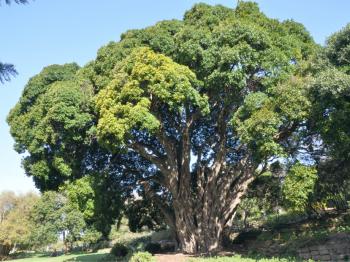
Description
Description
Ficus craterostoma is a small to medium-sized, evergreen tree, 5–10 m tall, occasionally reaching 20 m, with a rounded, spreading crown. Bark is grey, sometimes mottled, smooth with fine longitudinal cracks. It has aerial roots that, in time, thicken and grow together, developing into a large, buttressed trunk. Leaves are alternate to sub-opposite, variable, small, 30–95 × 17–52 mm, broader at the apex and often blunt-tipped, glossy, hairless, dark green, with a wavy margin and are held stiffly.
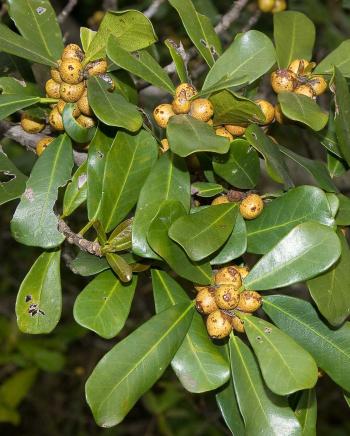
Small globose to ellipsoid figs, up to 15 mm in diameter, are produced in pairs in the axils of leaves of young twigs in summer (November to March). They are often crowded at the tip, occasionally, if flowering conditions are not favourable, as a few single figs on the stem. The figs are stalkless, hairless, warty with reddish spots and ripen to yellowish red.
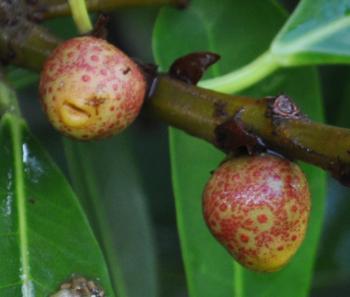
Ficus craterostoma may be confused with F. natalensis (coast strangler fig), but the latter has figs with stalks and its leaf apex is usually rounded. Another similar species is F. burkei (common wild fig), but its figs are larger and are usually hairy.
Conservation Status
Status
According to the Red List of South African plants, Ficus craterostoma is not threatened, and is assessed as Least Concern (LC).
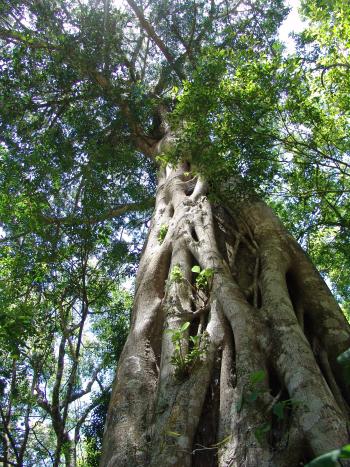
Distribution and habitat
Distribution description
Ficus craterostoma grows in moist, evergreen forest, riverine and swamp forest, coastal forest and in deep, heavily wooded mountain ravines, always in high rainfall areas. In South Africa it occurs from the Great Kei River in the Eastern Cape northwards through KwaZulu-Natal and Mpumalanga to Limpopo. It also occurs in Swaziland, western Mozambique, eastern Zimbabwe, Malawi, Zambia, DRC, Angola, westwards to Sierra Leone and eastwards to Uganda and Tanzania.
Derivation of name and historical aspects
History
The name Ficus is the Latin name for ‘fig’, possibly derived from the Persian fica, or Hebrew fag. The species name craterostoma, means ‘bowl-shaped mouth’ from the Latin crater, ‘a bowl’ and the Greek stoma, meaning ‘mouth’ and refers to the shape of the opening, or mouth, of the figs.
The genus Ficus is one of 37 genera in the Moraceae, a family whose members all have milky sap, leaves that are simple or lobed (never pinnate) and a stipule that covers the growing tip. There are about 750 species in the genus Ficus, most of them, about 500 species, occur in Asia and Australia, 150 species occur in the Americas and 110 species in Africa and Madagascar. There are 48 species in southern Africa (Burrows 2003).
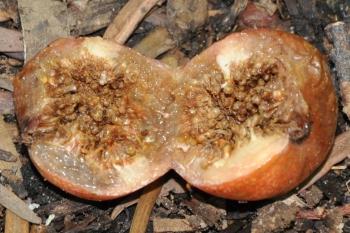
Ecology
Ecology
A fig is a flowerhead that has been turned inside-out. The fleshy outer part is the receptacle that has closed in on itself, to form a hollow sphere. There are hundreds of tiny male and female flowers on the inner surface, and can only be seen if a fig is broken open. A fig inflorescence is termed a synconium. The flowers are sealed up inside the hollow sphere, except for a tiny opening at the tip, called the ostiole. All figs are pollinated by wasps, called fig wasps. They are tiny, 1–2 mm long, and are attracted by a scent given off by the fig. The wasp enters the fig through the ostiole and lays its eggs in some of the flowers, and also pollinates some of the flowers. Once pollination is successful, the ostiole seals up. The wasp larvae feed on some of the developing seeds. When the wasps are fully developed, they mate inside the fig, the wingless males eat a hole through the fig wall, which allows the winged females to escape, and start the whole process again. Once the female wasps have left the fig, the seeds ripen and the fruit matures and attracts fruit-eating birds and bats, and monkeys, which eat the figs and disperse the seeds in their droppings. Mammals that can’t climb or fly, such as antelope, eat the dropped figs, and squirrels and rodents eat the seeds in the figs. What is remarkable about figs is that each species of fig has a particular species of fig wasp that pollinates it. The relationship between the fig and its fig wasp, is an example of mutualism, because both parties benefit. Figs are only pollinated by the wasp and the wasp only reproduces in the figs. In southern and eastern Africa, Ficus craterostoma is pollinated by Alfonsiella pipithiensis and in central Africa, it is A. michaloudi. At Kirstenbosch National Botanical Garden in Cape Town, these wasps do not occur, so the figs on the Ficus craterostoma specimens in the Garden remain unpollinated and no seeds, or ripe fruits, are produced.
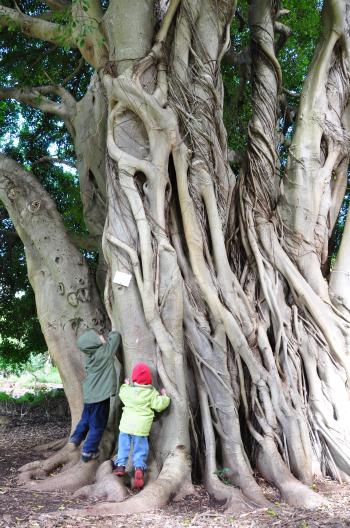
Strangler figs are so named because, if a seed is dropped on to a branch of another tree, it germinates and sends long aerial roots down to the ground. From there the young fig develops more roots and stems, that can branch and fuse with each other, and in time it can completely smother or ‘strangle’ and eventually kill the tree it happened to land on. Trees that germinate and grow in soil, also send down aerial roots from their branches, which ‘strangle’ or buttress their own trunk, or form vertical supports on side branches. This fig is also seen growing as a rock-splitter; these are plants that originate as a seed that landed on rocks, and the aerial roots have grown down or through a crack in the rock, or over the rock surface, until it finds soil.
Uses
Use
The figs are edible, but are small and insipid tasting, and probably only eaten when food is very scarce. They can also be made into jam. When eating wild figs, always break them open first to discover how many wasps or wasp larvae you will be eating too.
Ficus craterostoma is probably used in traditional medicine in the same way as Ficus natalensis. They look very similar, are often mistaken for each other and share many common names, but Ficus craterostoma is less known because of its more limited distribution. Ficus natalensis bark is sometimes an ingredient in imbembe, taken during pregnancy to ensure an easy birth. Grated raw roots are steeped in water overnight and a tablespoonful taken in water three times daily to cleanse the blood. Leaves are used as compresses and poultices for wounds, boils, warts and other growths.
With its buttressing, strangling and rock-splitting roots, be sure to keep this tree strictly in its container, or plant it far away (at least 5 m) from houses, walls, paths, swimming pools and sewer lines.

Growing Ficus craterostoma
Grow
Ficus craterostoma is not often seen in cultivation, but it is an easy-to-grow tree for frost free regions, and a handsome container or bonsai subject. Grow in well-drained, fertile soil, in full sun. Water well and regularly for at least a year to establish. It needs plenty of water. The ‘Big Fig’ in the Dell at Kirstenbosch is a very handsome, 80 year old specimen, planted in the 1930s.
It can be propagated from seed and cuttings. Harvest seed from ripe, wild grown figs, or pick them up from the ground. Open the fig and dry in the shade for a day. They are best sown fresh but can be stored after drying in a cool, dry spot for a few months. Sow in spring. Gently break up the dried figs using your fingers, spread the mixture of seeds and dried fig on the dampened sowing medium, cover lightly with a sowing medium, place the trays in a well-ventilated, warm, well-lit spot and keep moist. Use a free-draining, sterilised sowing medium. Water the seed trays using a fine rose or water from below. Under ideal conditions, seeds should germinate in 10 to 12 days. In cold areas, placing the trays on bottom-heated benches, will stimulate germination. Trays should be treated with fungicides to combat damping off. Feed the seedlings with dilute fertiliser, 50% normal dose is recommended, and place them in a sunny position. Pot them up into small pots about 2 weeks after germination, into a well-drained, hummus-rich soil and place in full sun. Young plants grow rapidly, pot them up into larger pots as and when their roots appear out of the drainage holes.
Take softwood or semi-hardwood cuttings in spring or early summer, as new growth starts. Place in washed river sand in a warm place with high humidity. Cuttings should root in about a month.
References
- Boon, R. 2010. Pooley's trees of eastern South Africa, a complete guide. Flora & Fauna Publications Trust, Durban.
- Burrows, J. & Burrows, S. 2003. Figs of southern and south-central Africa. Umdaus Press, Hatfield.
- Burrows, J.E. & Victor, J.E. 2005. Ficus craterostoma Warb. ex Mildbr. & Burret. National Assessment: Red List of South African plants version 2017.1. Accessed on 2017/08/17.
- Coates Palgrave, K. 1983. Trees of southern Africa. Struik, Cape Town.
- Hutchings, A., Scott, A.H., Lewis, G. & Cunningham, A.B. 1996. Zulu medicinal plants: an inventory. University of Natal Press, Pietermaritzburg.
- Jackson, W.P.U. 1990. Origins and meanings of names of South African plant genera. University of Cape Town.
- Van Noort, S. & Rasplus, JY. 2017. Figweb: figs and fig wasps of the world. http://www.figweb.org/Ficus/Subgenus_Urostigma/Section_Galoglychia/Subsection_Chlamydodorae/Ficus_craterostoma.htm (Accessed on 17 August 2017).
Credits
Alice Notten
Kirstenbosch National Botanical Garden
September 2017
Plant Attributes:
Plant Type: Tree
SA Distribution: Eastern Cape, KwaZulu-Natal, Limpopo, Mpumalanga
Soil type: Sandy, Loam
Flowering season: Early Summer, Late Summer
PH: Acid, Neutral
Flower colour: Green
Aspect: Full Sun, Morning Sun (Semi Shade), Afternoon Sun (Semi Shade)
Gardening skill: Easy
Special Features:
Horticultural zones









Rate this article
Article well written and informative
Rate this plant
Is this an interesting plant?
User Comments
Colin Jennings, South Africa
November 26, 2021 at 11:12 AMA very interesting article, most informative.
Thank you.
Login to add your Comment
Back to topNot registered yet? Click here to register.